By Jeffrey A. Rendall; Photos by Jeff Smith
ALDIE, VA – Golf legend Jack Nicklaus says his goal in developing golf courses is simple: to do something positive on a particular piece of property – to make it look good, make it a place where people want to come and spend time, and make it a place that’s better off for his having been there.
Judging by that standard, Nicklaus’s work at Creighton Farms is a smashing success, because there’s little doubt that Creighton Farms is the greater Washington DC area’s best new private golf course that’s appeared in recent memory.
Set in Loudoun County, about ten minutes south of Leesburg off of Highway 15, the Nicklaus signature designed Creighton Farms’ location already has a lot going for it – it’s surrounded by some truly beautiful Virginia countryside, with miles and miles of horse farms, wooded glades and rolling hills bordering the club. The combination of settings makes this part of Virginia one of the most scenic – and fastest growing.
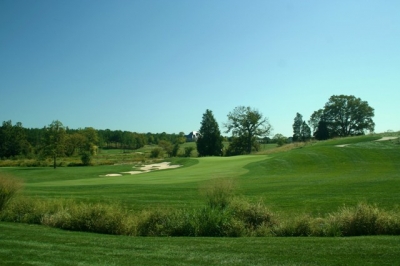 |
| Right from the start you'll grasp the nature of Creighton Farms' beauty - wide open spaces and pleasingly rustic scenery. Here, looking at the par four 1st hole. |
So much is made these days about the desirability of leaving land like this untouched so that it will retain its pristine beauty – but folks like Nicklaus are proving at places like Creighton Farms that a human hand doesn’t necessarily undo what God had in mind. Creighton Farms still feels very ‘natural,’ even with a championship golf course and upscale homes sharing the surrounding environment.
It also gives real estate ‘improvement’ the positive impact that Nicklaus was talking about.
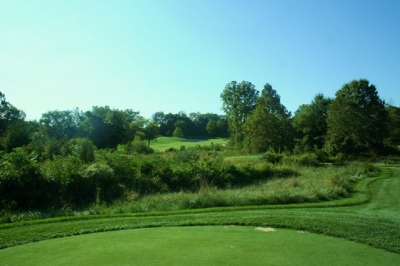 |
| Jack Nicklaus is known for designing terrific short par fours - and Creighton Farms' 14th hole certainly fits that description. |
The fact that Creighton Farms even exists at all is a testimony to all the parties’ persistence and belief in the project, seeing as it went through an ownership change late in its development and featured a virtual parade of people who worked on the project. Nicklaus joked at the Grand Opening that he was the only one who was involved from start to finish – and that probably isn’t far from the truth.
Southworth Development stepped in when times were looking particularly bleak for the project’s original ownership group, and Nicklaus credits the principals (David Southworth and Joe Deitch) with saving the golf course and allowing it to evolve into the outstanding layout that it is today. Creighton Farms’ clubhouse is not yet complete, but judging by a quick perusal of the ambitious floor plans, it will be as impressive and classy as the golf course when finished.
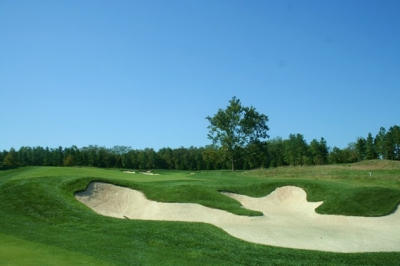 |
| As you'd expect from a course that Jack Nicklaus designed, fairway bunkers are strategic and punishing if you find them off the tee. Here, the par five 3rd hole. |
Nicklaus’s firm has designed over 340 golf courses in several dozen countries around the world (not to mention the thousands of golf courses he’s seen and played), yet he says Creighton Farms certainly holds its own with the best of the best: “This golf course, from a playing standpoint would stand up favorably to anything you want to put up to it. You could even put a Tour event or a U.S. Open here, if you could solve the logistical issues – but it’s not designed just for that. We’re trying to create more than just a place to play golf or hold events – we’re trying to create an experience.”
Nicklaus continues, “We used to design courses from the back tees and then move forward. But today, with professional players hitting the ball so far, we’ve stopped designing from the back tees forward – instead we put a lot more emphasis on making sure the game from the members’ tees is what it should be for the people who are going to be playing the course 51-weeks a year, minimum.”
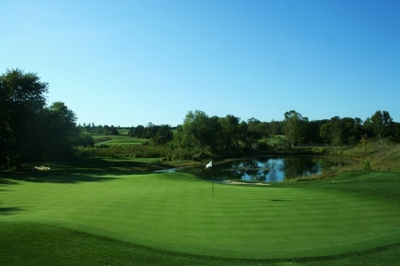 |
| Looking back from the green of the par three 15th hole. |
Nicklaus indicated that they also always throw in a set of ‘gorilla’ tees for the long-hitters, so the strategy of the layout works for all types of players. Creighton Farms’ Professional tees are over 7400 yards (with a slope of 152), so there’s more than enough challenge for even the best players in the game.
“It used to be the average golfer hit the ball 30 yards shorter than the average pro,” Nicklaus elaborated. “Well today, there’s probably 70 or 80 yards of difference between the two. So it’s a real challenge to design something that’s capable of handling both types of play, and I certainly think Creighton Farms fits that description.”
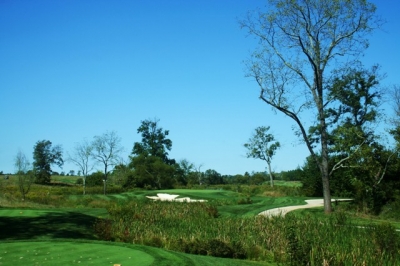 |
| Jack Nicklaus says the par three 6th hole fit well with the routing because there was just enough exposed land in the wetlands to make a green. |
Creighton Farms’ main defenses involve some pretty sloped, tricky greens – but that’s the last line of defense on all of the new courses these days, according to Nicklaus. Greens need to have some slope to them and offer tucked potential pin placements in order to challenge better players, because length (mainly due to equipment advances) no longer scares them.
Nicklaus is quick to point out that even though it would seem that golf course design is becoming pretty standardized these days, every golf course is different, because every piece of land is different. The only thing Jack’s golf courses have in common is they’ve all got eighteen holes, and all were built on land.
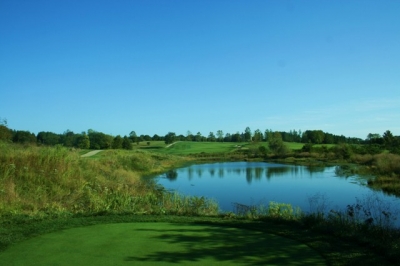 |
| You'll need about 200 yards of carry to reach safety on the par four 16th hole from the professional tees - but the distance is much more manageable from the other sets. |
“On this particular property, we had a lot of wetlands to be concerned with,” Nicklaus remembered. “We also had a lot of septic drain fields to work around. You obviously want to respect what vegetation you have on the property that is significant, and the Washington area is always a challenge in choosing the right grasses for the course because of the nature of the climate – it’s kind of a transition between north and south.”
Nicklaus should be familiar with Creighton Farms’ unique ‘problems,’ since he made ten or twelve visits to the site over the course of construction, and likes to stay involved with all of the ‘on top of the ground’ matters when the holes are being built. He’ll leave the engineering and drainage issues to the on-site managers, but when it comes to the width of fairways, slope of greens or placement of the bunkers, he takes it personally.
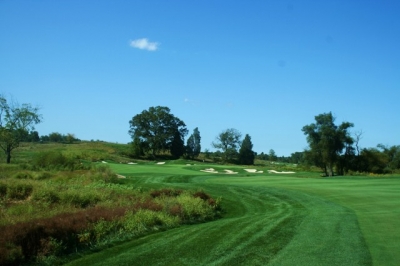 |
| The long and challenging par five 7th hole will test you on all three shots to the green. |
Though he doesn’t necessarily get involved with the ‘plumbing,’ Nicklaus says the below ground issues sometimes influence the golf design. Creighton Farms’ fairways are shaped such that finding a perfectly flat lie is fairly difficult – but there’s also a practical reason for it.
“We want a 2 to 3% pitch in all areas of your fairways so the water will move off when it rains – the last thing that we want is a soggy golf course, and we get some pretty heavy downpours in this area. But the golf course drains fabulously because through the slopes, we’re able to steer the water towards the natural or man-made basins,” Nicklaus explained.
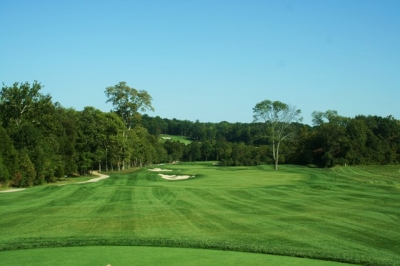 |
| There's 624-yards of real estate between you and the green on the par five 11th hole, but it's downhill most of the way, and a joy to look at from tee to green. |
The movement in the fairways is also part of the ‘style’ of the Creighton Farms course, which Nicklaus says isn’t really like a links course despite the fact that trees don’t come into play very often – he describes the club as having more of a ‘rustic’ flavor.
As far as the golf holes, Nicklaus says variety is what they were after at Creighton Farms. “The property dictates the golf holes to a large degree on every golf course, but you try to create variety wherever you can. You want to create as many dogleg lefts as you have dogleg rights. You want to create water hazards if possible. You try to create as many shots on the right that there are on the left, and you try to create greens that move right and some that move left.”
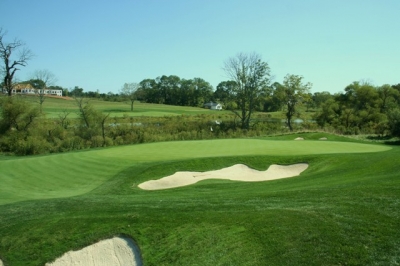 |
| Greenside at the par four 2nd hole, which at 359-yards is the front nine's shortest par four. |
He continues, “You try to keep your par threes going in opposite directions as best you can, and you try to get your par fives going in four different directions if at all practicable.”
Nicklaus noted that the land at Creighton Farms didn’t allow for the par fives to head in four different directions, but they managed to get three (the par five seventh and eighteenth both go the same way) different orientations. He says the routing of any course will usually change during construction to make everything fit well, including sometimes turning a planned par four into a par three or a par four into a par five – all in the name of creating variety.
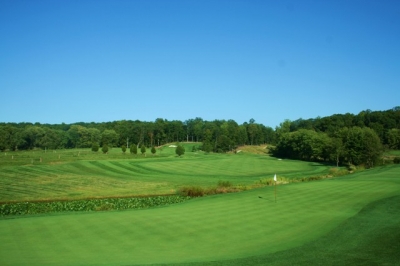 |
| The long and diagonal green of the par four 13th hole is fronted by a pond filled with lily pads - just one of the diverse terrain features at Creighton Farms. |
The par three sixth is an example of a hole that just fit the property at Creighton Farms, as Nicklaus said there was a tiny spot of land in a large wetland area on that part of the acreage that could be made into a green – and that’s how that hole came to be.
And although the layout at Creighton Farms (and all Nicklaus courses) is specific to the land it occupies, he said sometimes he’ll take ‘ideas’ from other courses and incorporate them into a new project. The long par four eighth hole is a good example of a concept that Nicklaus borrowed from a famous course – and although it bears little resemblance aesthetically to the hole it’s patterned after, it still conjures up images when you play it.
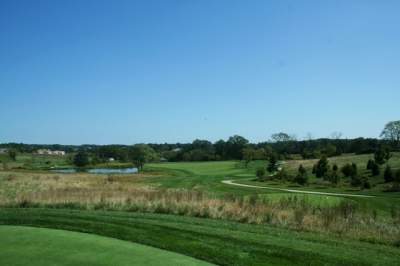 |
| There's no bailing out off the tee of the par four 4th hole - you'll need to challenge the hazard on the left to try and shorten your second shot on this long dogleg left hole. |
“The eighth hole is somewhat similar to the eighth hole at Pebble Beach (which is notoriously one of the most difficult holes in the world). I didn’t make the second shot quite as difficult, but the tee shots are very similar – you’ll have to play it basically blind to the top of the plateau and then be faced with a minimum 200-yard second shot into the green no matter how you play the tee shot,” Nicklaus explained.
“That situation just happened to fall there (the blind tee shot and the long second shot) because of the way the wetlands and the land were positioned,” Nicklaus went on. “I didn’t do at Creighton Farms what they did at Pebble, which would’ve required you to take the second shot over the edge of the wetlands to reach a green cut out of a hazard – I didn’t want to be that sadistic – so because the tee shot was tough and the second shot was long, I gave players more room to play that second shot.”
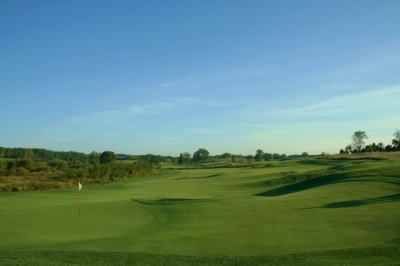 |
| A glance back from behind the green of the par five 18th hole will remind you of all the reasons why you'll want to play at Creighton Farms again. |
Solving the difficult eighth is only one example of the type of thought process you’ll need to be successful at Creighton Farms, but Nicklaus says he likes to create golf courses that make you ‘think’ on every shot in any case.
“I’m big on thinking,” Nicklaus lectured. “As a player, I always enjoyed courses that challenged me and made me think about how I want to play shots. You can go to a lot of the golf courses that are in the top ten in the country and probably play half the holes asleep. To me, that’s just not fun. With my course designs, I try to make the average golfer go to a level that they can do it within their abilities and think within their abilities and make it happen. That’s what I’ve tried to do with all the holes at Creighton Farms.”
It’s safe to say Nicklaus succeeded in that goal – Creighton Farms requires a lot of thought and creativity from the first tee until the final putt on the eighteenth green. The course’s variety certainly prevents you from getting bored as well.
Head Golf Professional Michael Vidal says even professional course raters have been surprised by the layout’s variety. “When the course first opened, we had raters come out and play it – and they were all blown away from the variety of golf holes we have here. I’ll never forget what one of them said when he left – he said he’s played just about all the top golf courses in the world along with many, many others, and Creighton Farms was the first course he’s played with ’18 Golf Holes.’”
The folks who get to see all the best courses have passed out awards as well, with Creighton Farms being named Golf Digest’s #6 best new private course for 2008; Golf Magazine’s #4 best new private course for 2008 and Travel and Leisure’s #3 best new course in the world – it’s one of only two courses to have made all three lists.
The awards are nice, but trophies alone won’t entice players to join the club (note: membership is by invitation only). Vidal says if the golf course doesn’t put you over the top, then the service element will. “We want our members and their guests to leave with the thought that this was their home away from home. We want them to not have any worries while they’re here and to feel comfortable that if they need or want anything – all they need to do is ask and we’ll do everything possible to make it happen. They should feel just as comfortable here as they would in the confines of their own home.”
With a golf course and overall club experience as fine as that of Creighton Farms, it shouldn’t be hard at all to impress members and guests – and keep them craving to return.
Details:
22616 James Monroe Highway
Aldie, VA 20105
Phone: 703 957-4805
Website: www.creightonfarms.com
Course Designer: Jack Nicklaus
Owner and Developer: Southworth Development
Head Golf Professional: Michael Vidal, PGA
Tees/Yardage/Slope/Rating
Professional 7410 152/77.0
Back 6858 145/74.1
Member 6223 135/71.2
Member (L) 6223 149/77.7
Forward 5008 127/70.3
Membership:
Membership is by invitation only.
| Related Links | Comments on this article? | |
|
Maryland National Golf Club Hollow Creek Golf Club Rocky Gap Resort PB Dye Golf Club in Ijamsville Whiskey Creek Golf Club |
E-mail Jeff Rendall, Editor: jrendall@golftheunitedstates.com |












